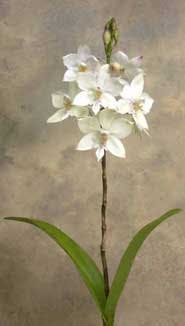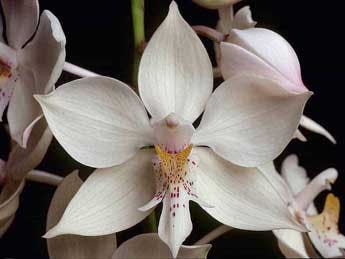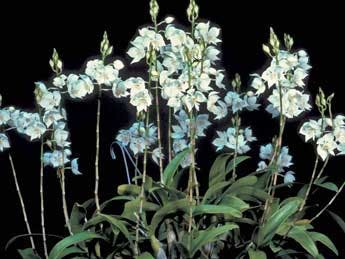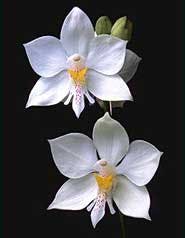Caularthron bicornutum (W. J. Hooker) Rafinesque
(kawl-AR-thron bye-korn-U-tum)

Flowers are well-held on a tall inflorescence that needs no staking.
Synonyms:
Diacrium amazonicum Schlechter Diacrium bicornutum Bentham Epidendrum bicornutum W. J. Hooker.
Etymology:
The genus name Caularthron is derived from the Greek kaulos, meaning stem, and arthron, meaning joint, referring to the persistent leaf bases that accentuate the appearance of the nodes. The species epithet refers to the two hollow callus projections that can be nearly as large as the lateral lobes of the lip.
Blooming Period:
Flowers in January in nature and can be as late as May to June in cultivation. Plants here in South Florida are in spike now (1/16/09). Blossoms are produced in sucession so flowering can last for several weeks. Flowers have a light citrusy fragrance. We find that the inflorescence is a delicacy to sucking insects and usually keep a hand sprayer with 1tsp. Orthene® to 1qt. of water nearby. A squirt or two every few days will discourage aphids and thrips from destroying the bloom spike.
Distribution:
Long known under the name Diacrium bicornutum, this species is found north of the Amazon River along the northern portions of South America and in Trinidad and Tobago at elevations of 650-2450 feet (200-750 meters). Caularthron bilamellatum, a closely related species, is found in the same area as well as Central America. Many populations of Caularthron bilamellatum are cleistagamous (self-pollinating) and the flowers do not open fully, or open only briefly. The two species meet in Trinidad and Tobago. In nature the hollow pseudobulbs are frequently home to stinging ants!

Caularthron bicornutum 'For Mark' AM/AOS Exhib: Sandra Denman
Description:
The pronounced pseudobulbs are spindle-shaped, to 11.7 x 2.3 in. (30 x 6 cm). Each pseudobulb carries 2-3 oblong-elliptic, obtuse, leathery leaves up to 7.8 x 2 in. (20 x 5 cm). The terminal inflorescences are erect, long-pedunculate racemes to 25.4 in. (65 cm) long. Inflorescences carry 4-20 white flowers; the basal half of the lip spotted dark red and the callus bright golden yellow. Sepals are ovate-elliptic, subacute, to 1.3 x 0.7 in. (3.2 x 1.8 cm). Petals are broadly elliptic to suborbicular, abruptly acuminate, to 1.1 x 0.9 in. (2.8 x 2.3 cm). The three-lobed lip is up to 1.1 x 0.6 in. (2.8 x 1.5 cm), the lateral lobes oblong, obtuse, subparallel to the midlobe, the midlobe linear-lanceolate, acute, about twice the length of the lateral lobes, the callus a pair of high two-lobed horn-like keels. The column is semiterete, flared as broadly obtuse-rounded keels to either side of the stigma, to 0.8 in. (2 cm) long.

Caularthron bicornutum 'Arp's Snowflake' HCC/AOS Exhib: Gerald K. Arp
Culture:

Grow Caularthron bicornutum in small pots or baskets with a medium-grade epiphyte mixture. Provide warm temperatures, very bright to full light, and regular watering throughout the year. The roots should dry out fully between waterings. Care should be taken to avoid over-potting or too frequent watering as the root system doesn't respond well to disturbance or a decomposed medium. Plants also grow well mounted providing that watering needs can be met. Those living in frost-free climates can use it as a landscape subject. Attach divisions firmly to thin canopy trees. - AOS Publications Committee









